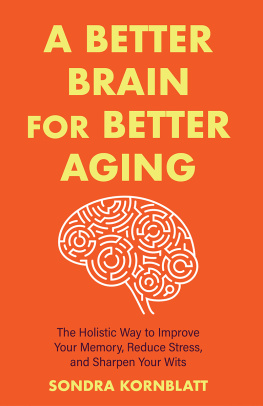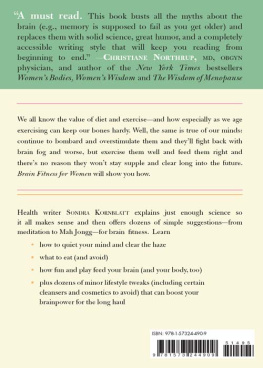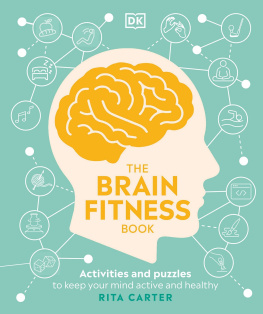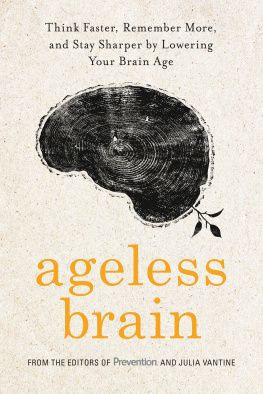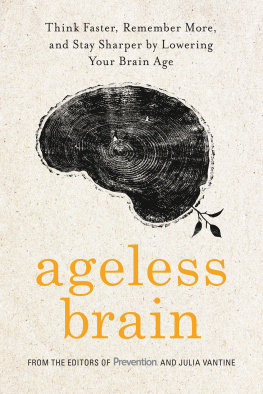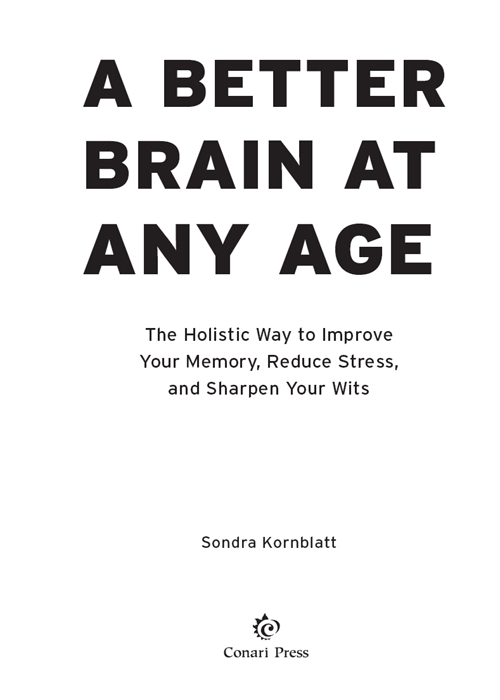
First published in 2009 by Conari Press,
an imprint of Red Wheel/Weiser, LLC
With offices at:
500 Third Street, Suite 230
San Francisco, CA 94107
www.redwheelweiser.com
Copyright 2009 by Sondra Kornblatt. All rights reserved. No part of this publication may be reproduced or transmitted in any form or by any means, electronic or mechanical, including photocopying, recording, or by any information storage and retrieval system, without permission in writing from Red Wheel/Weiser, LLC. Reviewers may quote brief passages.
ISBN: 978-1-57324-320-9
Library of Congress Cataloging-in-Publication Data
available upon request.
Cover and interior design by Maija Tollefson
Typeset in Berkeley
Cover illustration Christopher Hudson/iStockphoto
Printed in Canada
TCP
10 9 8 7 6 5 4 3 2 1
With love to my husband Howard, who died before seeing this book published. His active brain, loving heart, fatherly care, and deep spirit brought joy to our two decades together.
Contents
.
Chapter 1
A Short Tour of the Brain
Chapter 2
Not All in Your Head The Body-Mind
Chapter 3
Hey, Genius! Intelligence, Memory, Learning Styles, and Creativity
Chapter 4
Emotions and the Brain
When You Can't See the Forest for the Angst
Chapter 5
The Big Wide World and Your Brain
Chapter 6
Eating for Brilliance
Chapter 7
Meditation and a Bigger Perspective Less Is More
Foreword
Annaliese, a forty-two-year-old office manager, made an appointment to see me about Alzheimer's disease. She was sure she had it because she constantly misplaced her purse, forgot meetings, and couldn't remember names when she ran into old friends. While the memory results of her mental status exam didn't indicate serious cognitive loss, we spent some time talking about how Annaliese's brain could work better. I suggested she improve her sleep habits, be mindful of her diet, add some fish oil and other supplements, and examine how stress is created in her life.
The next time Annaliese visits, I will show her A Better Brain at Any Age, and she can peruse the hundreds of great ideas it containstried-and-true ideas and innovative complementary methods for enhancing the function of the brain.
During more than twenty-six years practicing medicine, I have seen results of practice using treatments that I learned in conventional medicines as well as those I have learned from more alternative practitioners and literature. I know what is sound. In this book, Sondra Kornblatt has created a balanced and holistic view of a healthy brain. All the methods in this book, conventional or alternative, are well researched and easy to understand. She addresses brain development from exercise and energy medicine to memory and meditation. Some of her suggestions are clever reminders for common brain-boosting ideas: exercise, eating vegetables, and getting fish oil. In other areas, she blends nutrition, aromatherapy, energy medicine, and more to compile intriguing ideas for the brain:
- Cinnamoneven a whiff of itimproves learning.
- Body alignment (balanced posture) increases brain blood flow.
- Rooms painted with contrasting colors stimulate learning.
- Volunteering reduces depression and stimulates the same pleasure center for eating and sex.
- Laughter Yoga classes or laughter tapes release healing laughter.
- Swinging arms when you walk works the two hemispheres of your brain.
- Fear can be reduced with psychological acupressure such as Tapas Acupressure Techniques (TAT).
- Creativity can be enhanced by nodding your head.
That's just a start. A Better Brain also provides a comprehensive list of toxins to avoid (from treated wood to new shower curtains) and good foods to eat (from saffron to avocado). This book covers the whole range of brain health with humor and respect for the amazing human body.
Studies have shown that attitude is critical in healthy brain function. A Better Brain at Any Age will help you support the attitude that respects your brain.
FERNANDO VEGA, M.D., SEATTLE, WASHINGTON
Acknowledgments
It took a village to raise a brain book: my wonderful community sustained me and my brain during the writing process. Let me introduce them to you.
The generous and helpful people I interviewed taught me so much more than would fit in this book. Deepest appreciation to Ragini Michaels, Dr. Fernando Vega, Dr. Joan Borysenko, Sally Kempton (Swami Durgananda), Narayana Granatelli, Dr. Eric Chudler, David Stizhal, Dr. Todd Clements, Dr. James Dalgren, Christopher Mascis, Dr. Ralph Kenney, Sharon Begley, Dr. Eric Maisel, Renna Shesso, and Carrie Lafferty.
My writing community provided sage editorial and expert advice, along with large doses of encouragement, particularly when I struggled with summarizing emotions in 250 words. Much gratitude to Anne Kornblatt, Ann Gonzalez, Jodi Forschmiedt (especially for help editing the final manuscript), Priscilla Long, Dr. Jean Milican, Sharon Maffett, Auky Van Beek, David Stitzhal, editors Caroline Pincus, Pam Suwinsky, and Brenda Knight, and the Seattle public libraries.
My friends and family buoyed me on the journey. Much love to Diane Rodriguez, whose support remains after she's gone. Michael Pitrone, Sonja Carson, and the Soiree community helped me laugh at myself and my stories. My parents gave support and love on many levels. Love to Howard, Milo, and Ella, who got sick of hearing about omega-3s and celebrated completed chapters at the dining room table.
You've all made my brain so much strongernot to mention my heart. Merci.
Note: Although I used the names of family, friends, and clients in the book, the examples in the book are composites. Even you, Mom. I've tried to accurately represent what my sources have told me, but I take responsibility for any misinterpretations or inaccuracies. This book does not include footnotes because they are so distracting. However, in the Bibliography and Resources section at the back of the book, I've listed the sources that I've used in my research.
Introduction: Change Your Brain, Change Your Life
Change is inevitableexcept from a vending machine.
ROBERT C. GALLAGHER
Can't remember the name of your doctor when you see him at the store? Forget your standing appointment for physical therapy? Worried about Alzheimer's?
Chances are, you're not stupid, rude, nor experiencing early dementia. Instead, your brain is frazzled: unhealthy habits, aging, long work hours, and information overload. Even with all this stress, you're not at a brain-dead end.
That's because your brain is changing. It changes every day, even as you read this sentence. The principal activities of brains are making changes in themselves, says Dr. Marvin Minsky in his book Society of the Mind.
You can support your brain by changing it more. When you create new connections, your brain becomes stronger. Your neurons (brain cells) get active and your brain stays plastic, able to create new neural pathways.
How do we know this? From new technology and research. In the past decade, technology such as SPECT (single photon emission computed tomography) scans and functional MRIs (magnetic resonance imagings) have shown brainwaves and brain function in action. Scientists have learned that the brain generates new neurons throughout life, that meditation increases gamma waves, and that movement changes thoughts.
Next page

